-
![]() Recover Deleted Files from USB Without Software [2026 Updated]
Recover Deleted Files from USB Without Software [2026 Updated] January 06,2026
January 06,2026 6 min read
6 min read -
![]()
-
![]() Free Download the USB Data Recovery Software Full Version | 2026 Best Choice
Free Download the USB Data Recovery Software Full Version | 2026 Best Choice January 06,2026
January 06,2026 6 min read
6 min read -
![]()
-
![]() Free | How to Recover Files from Formatted USB/Pen Drive
Free | How to Recover Files from Formatted USB/Pen Drive December 21,2025
December 21,2025 6 min read
6 min read -
![]()
-
![]()
-
![]()
-
![]()
-
![]()
Page Table of Contents
Suppose your USB drive turned into an ESD USB. Don't panic! It is a USB drive formatted to store Windows installation files, typically created with Microsoft's Media Creation Tool, which will remove all the data on the drive and create an ESD-USB partition on the disk.
However, you can still restore data from the ESD USB using a reliable flash drive repair tool. This page covers solutions to undo ESD on a USB drive and restore your device to its full capacity without losing data.
PAGE CONTENT:
What Is an ESD USB and Why Does It Matter
An "ESD USB" is a USB flash drive or external hard drive used for Windows installation, created from an Electronic Software Download (ESD) file, which is a compressed, more efficient version of the Windows installation image. If a drive was mistakenly formatted as an ESD-USB and you want to use it for general storage, you can restore it by reformatting it, typically through Windows' Disk Management, Command Prompt, or File Explorer.
- Method 1. Delete the ESD-USB Partition via Disk Management
- Method 2. Erase ESD-USB Partition Using Command Prompt
- Method 3. Format the ESD-USB Drive Using File Explorer
❗However, reformatting the USB drive may cause permanent data loss. It's suggested that you perform USB data recovery before converting the ESD USB back to normal.
Prerequisites: ESD-USB Data Recovery in 3 Steps
"Does someone know how to restore my 32GB ESD-USB 1TB external hard drive to normal? I mistakenly converted it into an ESD-USB drive while trying to create a Windows media creation tool. Now the drive only has a 32GB partition left. The rest partition and data were all gone."
When generating a bootable installation of Windows on your USB drive, you do so by using an ESD USB, which stands for "Electronic Software Delivery".

Besides the shown state of the ESD-USB drives in the above picture, you may also have experienced the listed symptoms on your hard drive or external hard drive:
- ❓USB drive or external hard drive only showing 32GB or 31GB in Windows Explorer
- ⚠️Partitions become unallocated on the ESD USB drive or external hard drive
If you create the Windows Media Installation Tool on the wrong drive, you will lose all partitions and data, leaving only a 32GB ESD-USB partition. The urgent task is to recover deleted files when your storage device turns into an ESD-USB drive.
It's recommended to apply file recovery software to scan and restore lost files from your ESD-USB drive first. If you have tried to convert an ESD-USB drive to normal by deleting the partition or reformatting the drive, that might overwrite your old files and cause permanent data loss. Go through this part and learn how to return your lost data as soon as possible.
Apply a professional USB data recovery tool, EaseUS Data Recovery Wizard, a practical and secure method to restore lost files from the ESD-USB device, to return your lost files immediately!
Download this outstanding USB data recovery software now and thoroughly scan existing and lost files from the ESD-USB drive and restore everything on the device in only three steps!
Step 1. Run USB Data Recovery Software
Connect the USB drive or pen drive to your computer and launch EaseUS USB data recovery software on your PC. Select the drive which is labeled as a External drives, and click "Scan for lost data" to start looking for lost files.
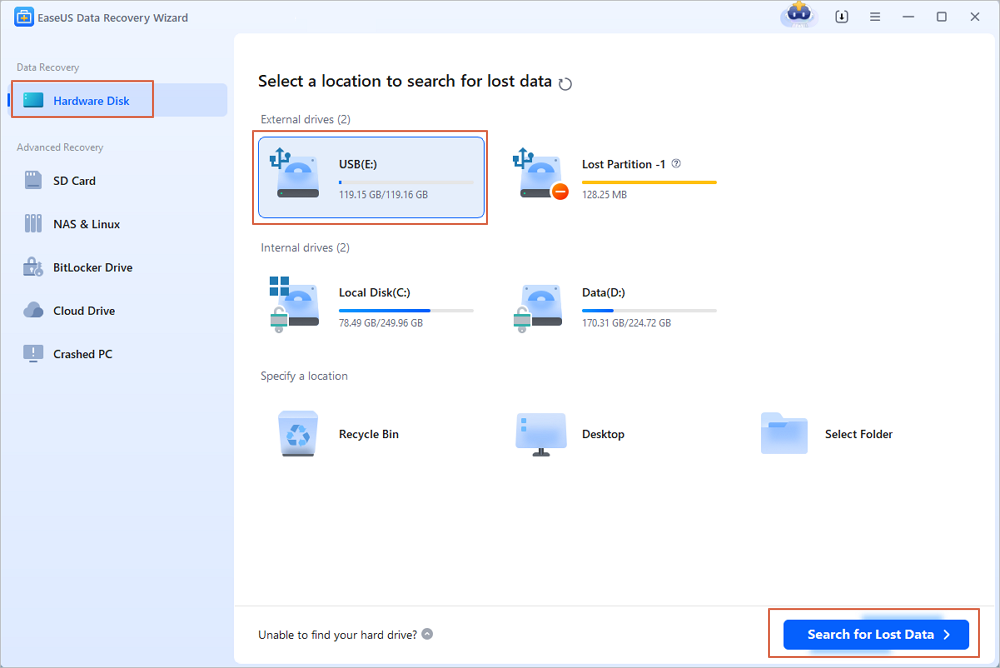
Step 2. Scan and Search Lost Files on a USB Drive
EaseUS Data Recovery Wizard will thoroughly scan your USB flash drive/pen drive and find all your lost data on it. When the scan process completes, use the Filter feature to find wanted files.
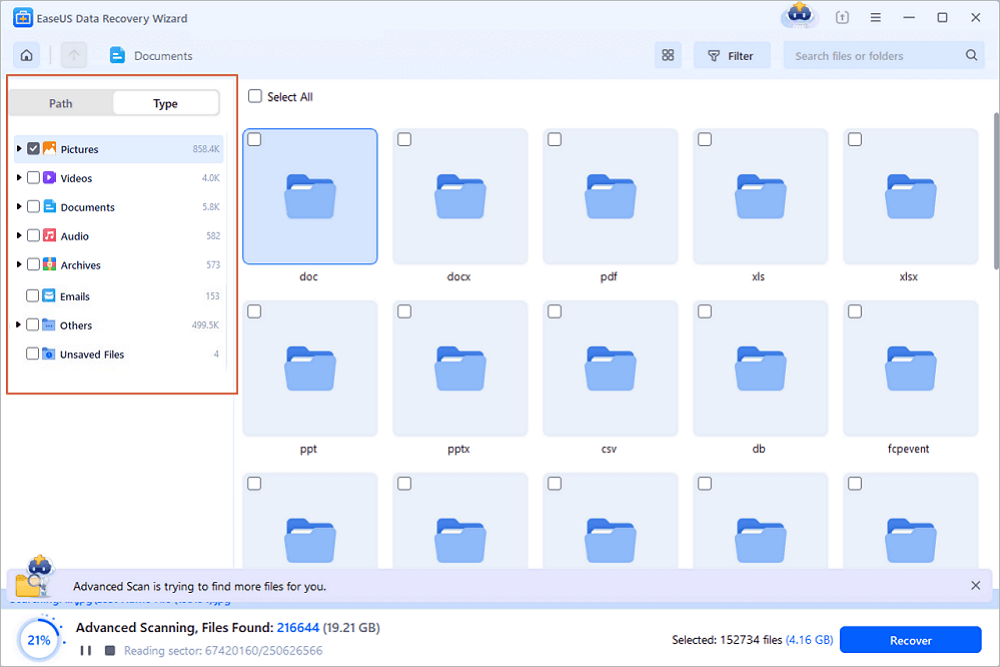
Step 3. Restore All Lost Files from USB
A double-click will allow you to preview the files. Select the target files to restore and click "Recover" to save them to a secure location on your PC or other external storage devices.
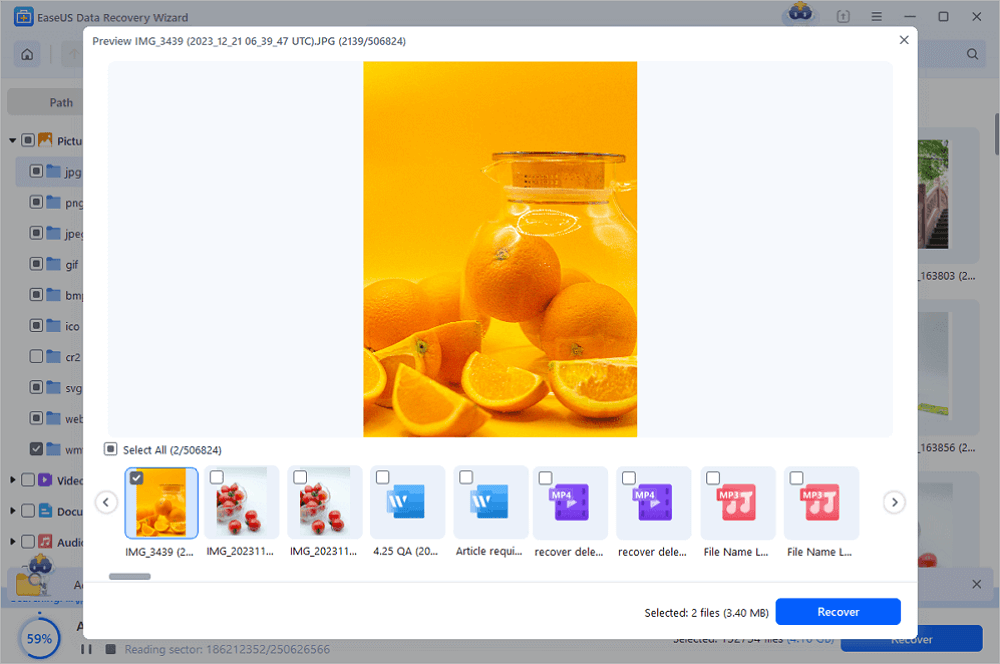
Many users trust EaseUS software, and you can check the reviews from Trustpilot or G2.
| 📒 |
Wonderful software,I had so much of my corrupted data on my sd card and could not find any way to recover that and so downloaded so many recovery softwares and the experience was best in EaseUS so easy to use, fast scanning and recovering unlimited data. Thanks EaseUS! - from Trustpilot |
| It is easy to download, open, maneuver through the options to recover data on an external drive, make a boot disk, backup and more. The scan was quick and found every file I thought I lost! - from Trustpilot |
After saving your valuable data, read on to learn how to convert your ESD-USB drive or external hard drive back to normal. Before that, don't forget to mark this helpful guide by sharing it on Facebook, Twitter, or SNS.
How to Convert an ESD USB Back to a Normal Drive
As you know, the existing ESD-USB partition only contains some Windows installation files you do not want. As a result, deleting the existing 32GB partition won't cause data loss on your drive. But you should know that it's not recommended to delete the ESD-USB partition while installing Windows.
Also, to prevent the restored data unopenable issue from happening, EaseUS data recovery experts suggest using file recovery software to scan the whole hard drive in advance. By the way, this software can also recover formatted partitions.
Now, follow the steps below to delete the ESD-USB partition to convert it back to a normal drive.
Method 1. Delete the ESD-USB Partition via Disk Management
Follow the steps below to delete the existing ESD-USB partition in Disk Management:
Step 1. Connect your USB drive or external hard drive to your PC and open Disk Management.
Step 2. Locate and right-click on your device's ESD-USB 32GB partition, and select "Delete Volume".
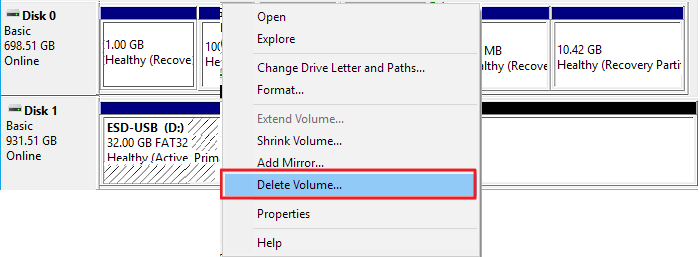
Step 3. Click "OK" to confirm.
After deleting the partition, the ESD-USB partition is no longer on your USB drive. The device should now be an unallocated drive.
Therefore, you can create a new partition on the device to undo ESD-USB. By doing so, you will be able to restore your HDD or external hard drive to total capacity:
Step 1. Enter Disk Management and, right-click on the unallocated space, select "New Simple Volume".
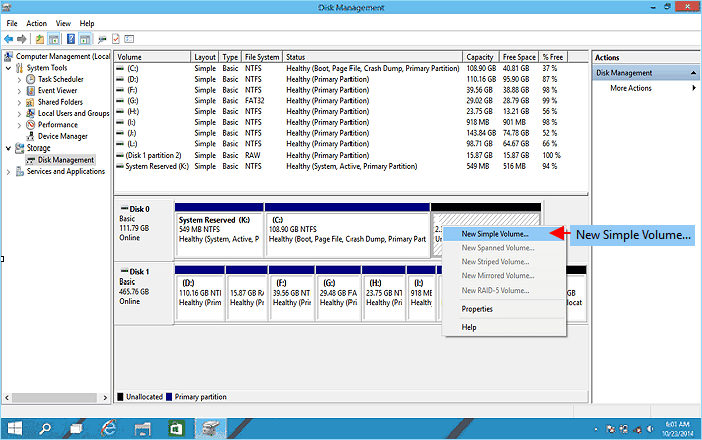
Step 2. Enter the New Simple Volume Wizard, and click "Next" to continue.
Step 3. Set the new partition size, file system - NTFS, and partition label on your hard or external hard drives.
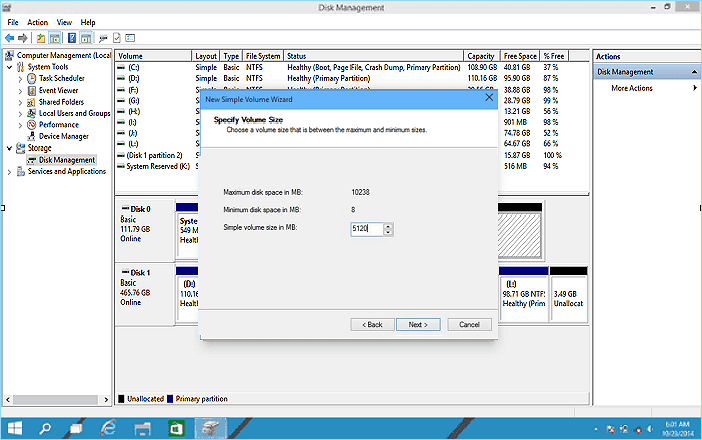
Step 4. When you finish all the settings, click "Finish" to complete the process.
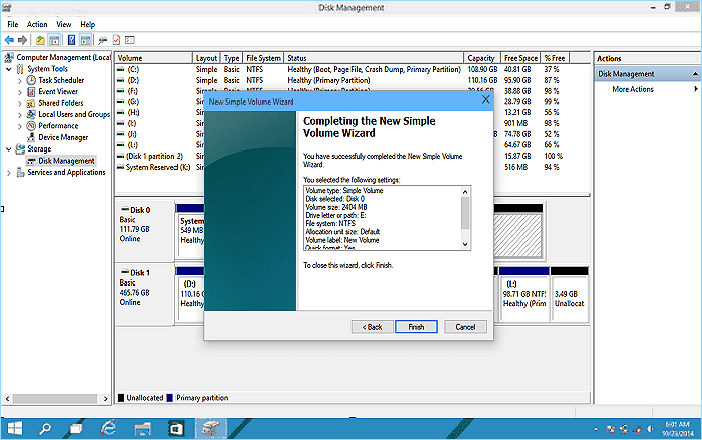
💡Note: If you need to create more than one partition on your hard drive, properly allocate the unused space and repeat the process.
After this, you can reuse your hard drive or external hard drive to store relevant data and files. Don't forget to share this passage on social media and mark it!
Method 2. Erase ESD-USB Partition Using Command Prompt
This method uses the powerful diskpart tool for low-level control.
Step 1. Press the "Windows + S" keys, type cmd, and right-click on "Command Prompt > Run as administrator".

Step 2. In the Command Prompt window, type diskpart and press Enter.
Step 3. Type list disk and press Enter. This will show a list of all storage devices connected to your computer.

Identify your USB drive based on its size (e.g., Disk 1). Be very careful to select the correct disk to avoid data loss on other drives.
Step 4. Type select disk X (replace X with your USB drive's number) and press Enter.
You will see a confirmation message: "Disk X is now the selected disk".
Step 5. Type clean and press Enter. This command will completely erase the partition table and all data on the USB drive.
🔔Note: To quickly format the drive with the NTFS file system, type format fs=ntfs quick and press Enter. You can replace ntfs with FAT32 if you need compatibility with older devices.
Step 6. Type create partition primary and press Enter.
Step 7. Type assign and press Enter. This will automatically assign a new drive letter. If you want a certain drive letter, like "E", type assign letter E.
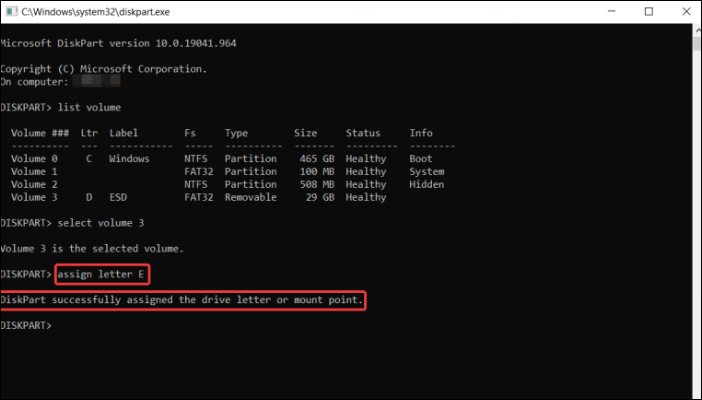
Step 8. Type exit and press Enter to leave DiskPart.
Close the Command Prompt window. Your USB drive is now back to a normal, usable state.
Method 3. Format the ESD-USB Drive Using File Explorer
This is the simplest method, but it may not work if the drive is write-protected or has multiple protected partitions.
- Warning
- Formatting a drive will delete all data. Therefore, make sure you save essential files using EaseUS Data Recovery Software before performing formatting.
Step 1. Open File Explorer by pressing the "Windows + E" keys.
Step 2. In the left navigation pane, find your ESD USB drive under "This PC" or "Computer".
Step 3. Right-click on the USB drive and select "Format…".
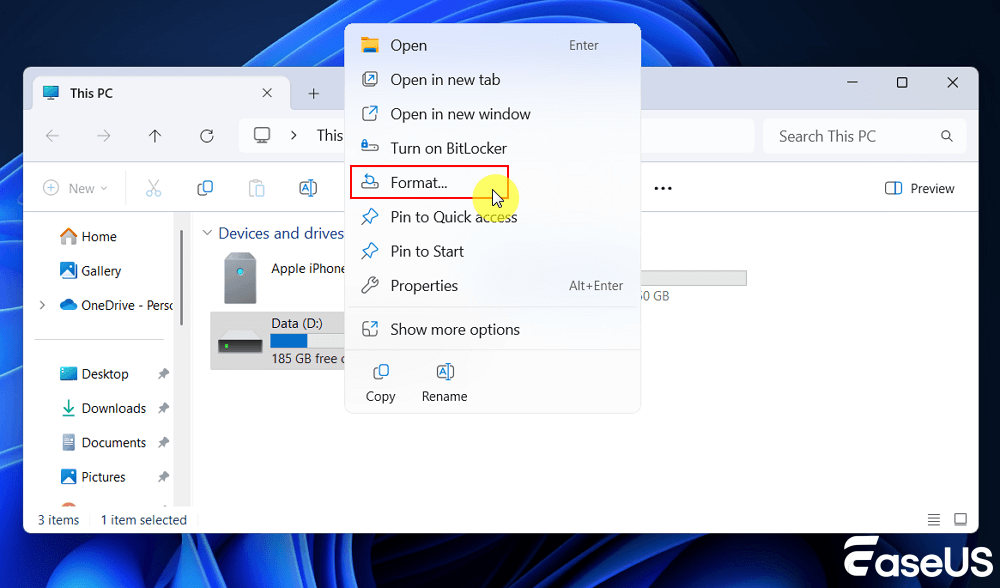
Step 4. Choose format settings:
- In the Format window, for File system, choose NTFS or FAT32.
- Ensure the "Quick Format" option is checked.
- You can change the "Volume label" to something like "USB Drive".
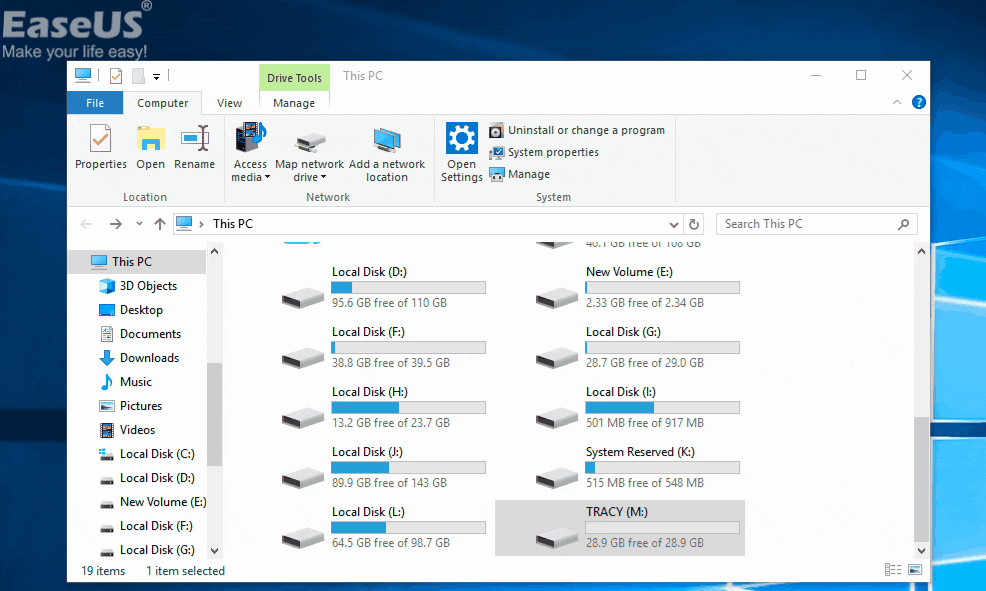
Step 5. Click "Start". A warning will appear stating that all data will be erased. Click "OK" to confirm.
Wait for completion. Once you see the "Format Complete" message, click "OK". Your USB drive will now function as a standard storage device. Don't forget to share this informative guide with your friends and help more people learn how to fix the "ESD USB" issue on a hard drive.
Keep the ESD USB and Create a New Volume/Partition
This is the second situation if you don't want to delete the data on the ESD-USB partition, which allows you to keep the existing ESD data (e.g., for Windows installation) while creating a new, separate partition on the same drive for general file storage. It is useful if you want a dual-purpose drive.
- Prerequisites
- The existing ESD partition must not take up the entire drive, or you must be able to shrink it. Some ESD USBs are created as a single, full-drive partition and cannot be easily shrunk.
Here are the steps:
Step 1. Press "Windows + R", type diskmgmt.msc, and press Enter to open Disk Management.
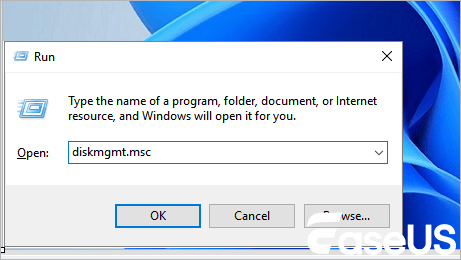
Step 2. Select your USB drive and analyze the USB drive layout. It will likely have one or more existing partitions (e.g., for the ESD files).
Step 3. Shrink the existing volume (if necessary)
If the existing partition uses the entire drive, you need to free up space.
- Right-click on the main ESD partition and select "Shrink Volume…"
- The system will query the available shrink space. In the Enter the amount of space to shrink in MB field, enter the size you want for your new partition (e.g., 16384 for 16 GB).
- Click "Shrink". This will create a block of "Unallocated" space on the drive.
Step 4. Create a new simple volume in the unallocated space by right-clicking on the "Unallocated" space and selecting "New Simple Volume…".
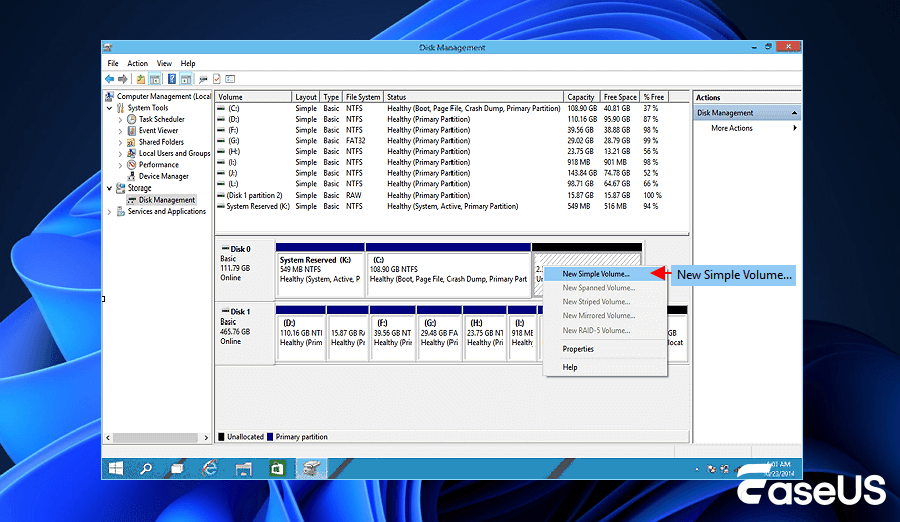
Step 5. Complete the New Simple Volume Wizard and click "Next".
Step 6. Confirm the size for the new volume (it should default to the entire unallocated space) and click "Next".
Step 7. Assign a drive letter that is different from the existing ESD partition and click "Next".
On the Format Partition screen, choose:
- File system: NTFS (recommended for large files) or FAT32.
- Allocation unit size: Default.
- Volume label: Give it a name like “DATA”.
Step 8. Check "Perform a quick format > Next", review your settings, and click "Finish".
Your USB drive will now have at least two volumes: one containing the original ESD files and a new, empty one for your personal files. You can use the new partition like a standard USB drive without affecting the ESD data.
How to Prevent Drives from Being Converted to ESD-USB
Besides, knowing how to protect your data and prevent hard or external hard drives from being converted to ESD-USB is crucial. Some reliable tips will assist you in resolving this issue with ease. Here are some reliable tips for you to apply and take action to protect your valuable files and storage devices immediately:
1️⃣. Create a Data Backup and Save It to Another Device or Cloud Drive
Creating a complete backup of your valuable files and data to another hard drive or external storage device is always a good habit. When data gets lost on your device, you can always bring it back from the backup.
A time-saving and effective method is to apply reliable file backup software for help.
2️⃣. Run Antivirus Software to Clear Viruses, Malware, etc. Regularly
You should also apply antivirus software for help. With reliable antivirus software, you can clear and remove the existing or hibernating viruses, malware, etc., from your hard drive or external storage devices.
Turning on Microsoft Defender is not enough, and here is a list of reliable antivirus software for you to try:
- Norton Security 360/Norton Antivirus Plus
- McAfee
- AVG
- Avira
- Avast
- Malwarebytes
- Kaspersky Antivirus
No matter which software you decide to use, once you finish the installation, run the software immediately. It will thoroughly scan your computer and external storage devices and remove potential viruses.
3️⃣. Encrypt and Lock Hard Drive/External Hard Drive with a Password
Another way to keep your device and data safe is to encrypt or lock your external hard drive with a password.
If you are a Windows 10/8/7 user, you can enable BitLocker on your device with the following steps:
Step 1. Open the Control Panel and click "BitLocker Drive Encryption".
Step 2. Locate and expand the drive or external hard drive that you want to lock, and select "Turn on BitLocker".
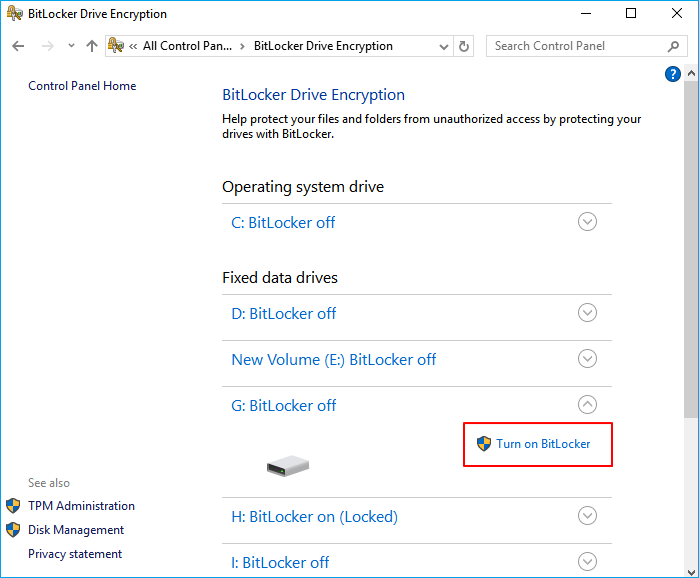
Step 3. Set a password to lock the selected hard drive or external hard drive and click "Next" to continue.
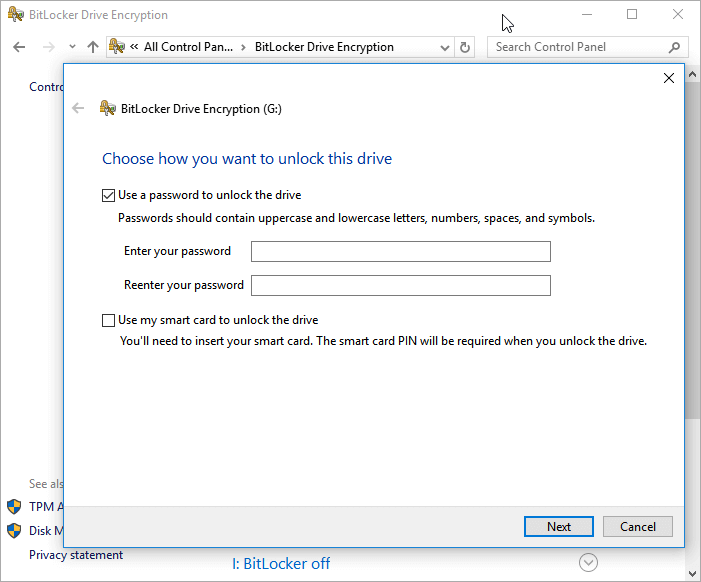
Step 4. Select a way to save your password to your Microsoft account, a USB drive, a file, or print the recovery key and click "Next" to confirm.
Step 5. Choose how much you of your drive to encrypt and click "Next" to continue -
- Encrypt used disk space only (faster and best for new PCs and drives)
- Encrypt entire drive (slower but best for PCs and drives already in use).
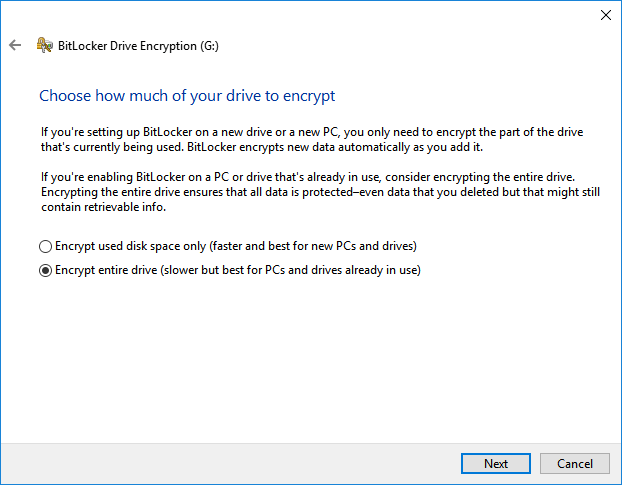
Step 6. Choose which encryption mode to use and click "Next" to continue -
- New encryption mode (best for fixed drives on this device)
- Compatible mode (best for drives that can be moved from this device).
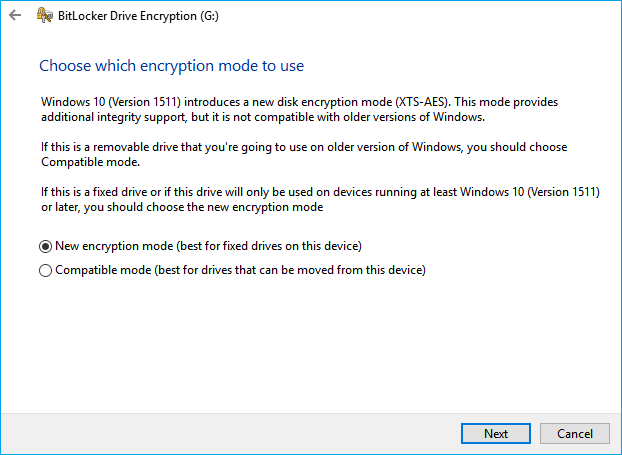
Step 7. Click "Start encrypting" and wait for the process to finish.

Besides, some reliable programs can lock and encrypt your drive with a password. By doing so, no one can directly access your data, hard drive, or external hard drive without a password.
- Tip
- When you need to access and use your files on the locked hard drive or external hard drive, here is how to unlock the device:
- 1. Keep your hard drive or external hard drive connected to your PC.
- 2. Double-click on your drive and enter the password which you've set for the BitLocker encryption.
- 3. After this, you can open your device and use the data securely again.
Conclusion
On this page, we've provided you with complete solutions to fixing the ESD USB issue on your USB drive or external hard drive. Use EaseUS data recovery software first to restore your essential data.
Then, solve the ESD USB issue by deleting or erasing the ESD-USB partition and creating new partitions. You can revert the ESD-USB drive to normal without data loss.
Applying the provided tips will also help you gain a complete plan to protect your data from being overwritten or prevent storage devices from being converted to ESD-USB by mistake.
Undo ESD-USB Hard Drive FAQs
Here are 4 additional questions about undoing ESD-USB hard drive. Check here for the answers.
1. How can I recover my data from ESD-USB?
A data recovery application like EaseUS Data Recovery Wizard is the best way to retrieve data from an ESD USB. What you can do is:
- Insert the ESD-USB stick into the computer's port.
- Install and launch EaseUS USB data recovery software on your PC.
- Select the ESD-USB and click Scan.
- Choose the target data and files and click "Recover" to restore them.
2. Is it possible to recover files after formatting?
Yes, files can be recovered after formatting. Previous data will be deleted when you format a storage device—for most users, wiping data after formatting results in permanently losing data. The old data, however, truly stays on the drive until new data replace it. You still have a chance to recover files after formatting if you didn't add any new files or directories to the formatted hard drive.
3. How can I recover files from a corrupted USB for free?
To recover files from a faulty USB, use free drive recovery software. To quickly recover images, movies, documents, and other things from a USB drive, try the free EaseUS data recovery program.
4. Can I install Windows 10 from ESD file?
Yes. To completely install Windows 10, get the ESD file and make your own bootable ISO files. Users may only get the bits for build 10041 through Windows Update, despite Microsoft's pledge to provide ISO files for every new version of Windows 10.
Was this page helpful?
-
Jaden is one of the editors of EaseUS, who focuses on topics concerning PCs and Mac data recovery. Jaden is committed to enhancing professional IT knowledge and writing abilities. She is always keen on new and intelligent products.…
-
Tracy became a member of the EaseUS content team in 2013. Being a technical writer for over 10 years, she is enthusiastic about sharing tips to assist readers in resolving complex issues in disk management, file transfer, PC & Mac performance optimization, etc., like an expert.…

20+
Years of experience

160+
Countries and regions

72 Million+
Downloads

4.9 +
Trustpilot Score


Free Data
Recovery Software
Recover data up to 2GB for free!














